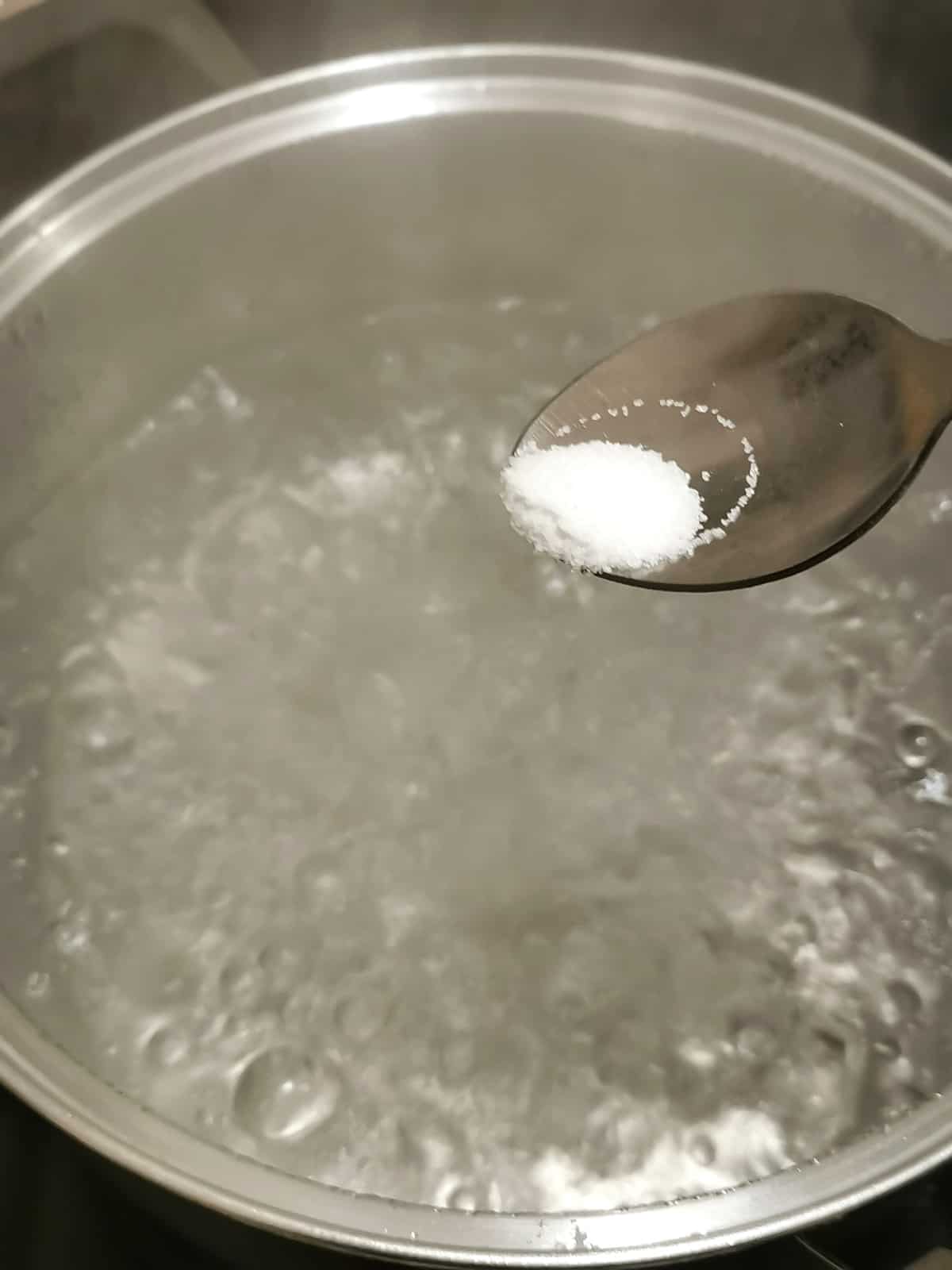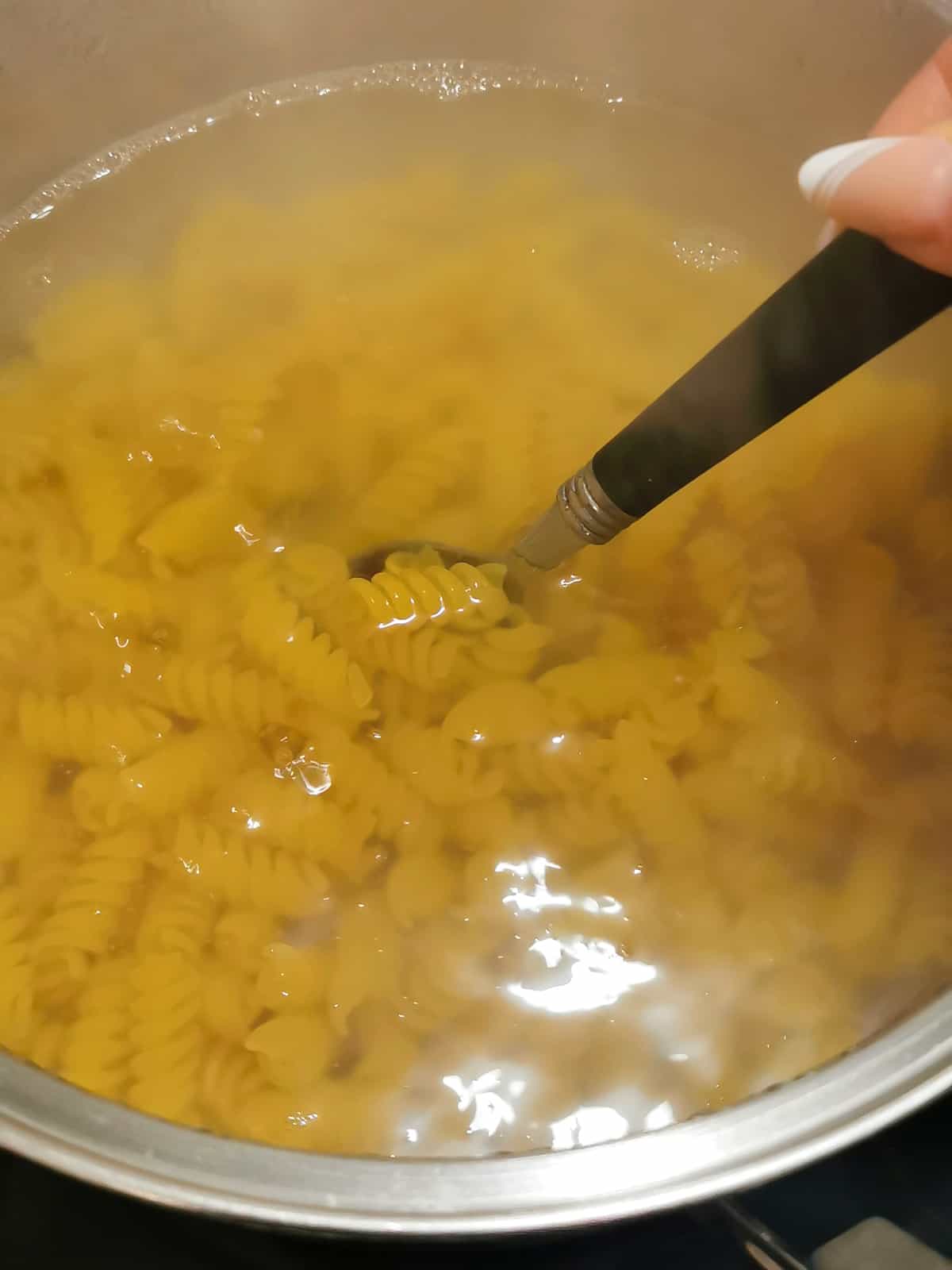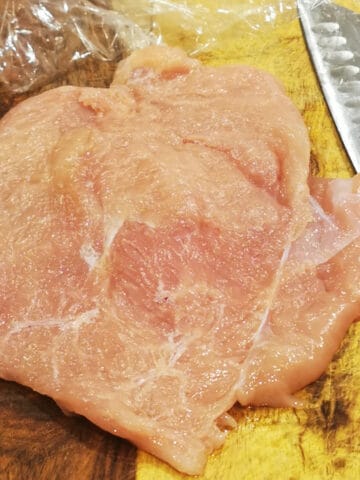In this How to Cook Pasta Al Dente step-by-step, fool-proof, guide, I'll show you the ways to achieve perfect al dente texture for different pasta varieties. Let's get started – apron on, water boiling, and let's dive into the heart of pasta preparation!

What is al dente pasta?
Cooking pasta al dente, which means "to the tooth" in Italian, refers to the ideal texture where the pasta is cooked but still has a firm bite when chewed.
To achieve al dente pasta, it's essential to follow the recommended cooking times on the pasta package and test the pasta a minute or two before the suggested time. The goal is to have pasta that is fully cooked but retains firmness.
Reasons to cook pasta al dente
- Texture: al dente pasta has a texture that is neither too soft nor too firm.
- Flavor: it retains more of its natural flavor. Overcooked pasta can become mushy and lose its distinct taste and character.
- Nutritional Value: Al dente pasta has a lower glycemic index compared to overcooked pasta. This means it has a slower impact on blood sugar levels.
- Versatility: it holds up well to various sauces and toppings.
- Tradition: Cooking pasta al dente is a traditional Italian practice. It's considered the authentic way to prepare pasta, and many Italian recipes specify this cooking style.
Most common pasta varieties and their uses

There are so many packaged dry pasta varieties available, each with its unique shape, texture, and ideal use. Here are a few common ones:
Long Pasta:
- Spaghetti:
- Versatile and can be used in a variety of dishes, including Spaghetti Bolognese, Spaghetti with Meatballs, Spaghetti Primavera, and so many others, including my Chicken in Spaghetti Nests!
- Cooking Time: 8-12 minutes
- Linguine:
- It's versatile and pairs well with a variety of sauces and ingredients. It's a classic choice for dishes like Linguine alle Vongole (with clam sauce).
- Cooking Time: 9-13 minutes
- Fettuccine:
- Fettuccine works well with a savory ragù. It's great with any cream sauce, mushroom sauce, pesto sauce, or tomato sauce. It pairs well with a variety of seafood as well.
- Cooking Time: 8-12 minutes
Short Pasta:
- Penne:
- Often used in tomato-based pasta dishes, baked pasta dishes like Baked Ziti, cold pasta salads, and the classic Italian-American dish Penne alla Vodka.
- Cooking Time: 10-12 minutes - may be longer, depending on its size.
- Rotini/Fusilli:
- Ideal for pasta salads, baked pasta casseroles, and cold pasta primavera.
- Cooking Time: 8-10 minutes
- Farfalle (Bowtie):
- Perfect for pasta salad, mixed with seafood dishes, or served with roasted vegetables, like in this Parmesan Pasta with Roasted Vegetables recipe.
- Cooking Time: 10-12 minutes
- Rigatoni:
- Commonly used in baked pasta dishes such as Baked Ziti or Rigatoni Al Forno. The ridges of rigatoni make it perfect for hearty meat sauces like Bolognese.
- Cooking Time: 12-14 minutes - may be more depending on the size of the pasta.
- Orzo:
- A small, rice-shaped pasta. Its size makes it a great option for salads, soups, and side dishes.
- Cooking Time: 8-10 minutes
- Shells:
- Smaller shells are great in soups, such as minestrone, and pasta salad dishes. Larger shells are perfect for stuffing! They can be filled with seafood, ricotta, and spinach mixture, possibilities are endless.
- Cooking Time: 10-12 minutes - may be longer for large shells.
- Egg Noodles:
- A classic choice for adding substance to soups, such as chicken noodle soup They are also used in various Asian dishes, such as lo mein and chow mein.
- The inclusion of eggs gives the noodles a softer texture compared to regular store-bought dry pasta.
- Cooking Time: 3-7 minutes, depending on their thickness.
To rinse or not to rinse pasta
My quick answer is almost always a "yes"!
Based on my own, personal, experience and after doing quite a bit of intensive research on the subject, here is what I found:
- Rinsing under cold water: rinsing pasta with cold water can stop the cooking process and help it cool down quickly without becoming mushy. This is especially useful for al dante pasta and if you're not immediately using it in a dish. It's great for pasta salads or cold pasta dishes.
- Rinsing under hot water: if you would like to rinse the starch from the pasta but need to keep it hot for your dish (soup, for example), rinse it under very hot water. I like to boil water in a kettle, place the cooked pasta in a colander, and rinse it in the sink with the boiled water.
- No rinsing: washing pasta can affect its texture and may impact how well sauces adhere to it. The starch also enhances the flavor and texture of the pasta, creating a better "marriage" between the pasta and the sauce.
Preparation
STEP 1: Boil Water

Fill a large pot with water, place it on the stove over high heat and bring the water to a rolling boil.
STEP 2: Add Salt

Once the water is boiling, add salt.
STEP 3: Add pasta

Carefully add the pasta to the boiling water. Stir it immediately after adding it to prevent sticking. Reduce heat to medium.
STEP 4: Stir Occasionally

Stir the pasta occasionally while it's cooking to prevent sticking and ensure even cooking.
STEP 5: Check for Doneness

Follow the package instructions for cooking times, but you can start testing for doneness a minute or two before the suggested time.
Taste a small piece of pasta to check for doneness. It should be "al dente," meaning it's cooked but still firm to the bite.
STEP 6: Drain

Once the pasta is cooked to your liking, turn off the stove and carefully drain the pasta in a colander or strainer in the sink.
STEP 7: Rinse

Rinse the pasta with cold water to stop the cooking process and cool it down quickly. This is more common for pasta used in cold salads. For hot dishes, rise it with hot water.
STEP 8: Add Olive Oil or Butter

You can toss the drained pasta with a bit of olive oil or butter to prevent sticking if you're not using it immediately.
Top Tips
- Ensure the water is at a rolling boil before adding the pasta. This helps prevent sticking - To speed up the boiling process, cover the pot with a lid while heating the water.
- Stir the pasta immediately after adding it to boiling water. This also prevents sticking.
- Cook pasta in batches or use a larger pot to prevent overcrowding. This ensures each piece cooks evenly.
- Taste the pasta a minute or two before the suggested time to ensure it reaches the desired al dente texture.
- Before draining the pasta, reserve a cup of the cooking water. The starchy water can be used to adjust the consistency of your pasta sauce if using.
- Don't use too much olive oil, as it can make it difficult for sauces to adhere to the pasta later.
How to store cooked pasta
Store the cooked pasta in an airtight container in the refrigerator for up to 4 days. If you won't be using all of it at once, divide the pasta into portion-sized servings and place each portion in airtight containers or resealable plastic bags. To reheat refrigerated pasta, you can quickly toss it in a pan with a bit of olive oil or warm it in the microwave - see below for more details on reheating.
To freeze the pasta, ensure it is completely cooled before transferring it to a freezer-safe container or bag. Frozen pasta can be stored for about 1-2 months. To reheat, let it thaw in the refrigerator overnight.
If possible, store the pasta and sauce separately to maintain the pasta's texture. Reheat the pasta and sauce separately and combine them just before serving.
How long to reheat pasta
The reheating time for pasta depends on the method you're using and the quantity of pasta you're reheating. Below is a general guideline:
- Microwave: Place the pasta in a microwave-safe dish and microwave on high for 1-2 minutes, stirring halfway through. Check the temperature and continue heating in 30-second intervals if needed.
- Stovetop: This typically takes 3-5 minutes. Heat a pan or pot on medium heat and add a bit of olive oil or sauce to the pan to prevent sticking. Stir the pasta frequently and heat until it reaches the desired temperature.
- Oven: Preheat your oven to around 350°F (175°C), place the pasta in an oven-safe dish, and cover it with foil to prevent drying. Heat for about 15-20 minutes, stirring halfway through.
- Steamer (for sauced pasta): place the pasta in a steamer basket over simmering water. Cover and steam for about 3-5 minutes until heated through.
- Pressure Cooker: Place the pasta in the Instant Pot with a bit of liquid (water or sauce) and set the Instant Pot to the "Manual" or "Pressure Cook" setting for 1-2 minutes. Allow natural release or perform a quick release.
Frequently Asked Questions
Yes, you can cook pasta in a rice cooker! Add pasta to the rice cooker and add enough water to fully submerge the pasta. The water-to-pasta ratio is typically around 4 cups of water per 1 cup of pasta. Then stir in salt. Close the rice cooker lid and turn it on, using the regular rice cooking setting. Periodically open the lid and stir the pasta to prevent sticking. Check it for doneness a couple of minutes before the suggested cooking time on the package to ensure it reaches al dente texture, then turn off the rice cooker. If there's excess water, you can drain it using a colander in the sink. Some rice cookers may absorb most of the water during cooking. Rinse as you usually would.
Cooking pasta directly from frozen is not recommended because it can result in the exterior being overcooked while the interior remains frozen. It's best to thaw pasta before cooking. However, If you're in a hurry and need to cook frozen pasta without thawing, add the frozen pasta to a pot of already boiling water and stir it occasionally to prevent sticking. Test the pasta for doneness; it may take a few extra minutes to cook through.
Cooking times for fresh pasta are typically much shorter than for dried pasta. Fresh pasta cooks quickly because it is generally softer. It usually cooks within 1 to 3 minutes. The cooking time depends on the thickness of the pasta and whether it contains eggs.
Serving suggestions
Serve the pasta cold, or room temperature, in salads and serve it hot as a side dish, like this Parmesan Pasta with Roasted Vegetables.
It's great served as a bed for Stir-Fried Chicken Thighs or Lemongrass Chicken with Bok Choy. Top the pasta with some Healthy Turmeric Oven Roasted Vegetables for additional nutrition.
Other how-to guides
If you tried this How to Cook Pasta Al Dente guide or any other guide or recipe on my website, please leave a 🌟 star rating and let me know how it went in the 📝 comments below. Thanks for visiting!
Recipe

How To Cook Pasta Al Dente
Ingredients
- 12 cups water cold
- 1 tablespoon salt see note 3 in notes section below
- 1/2 lb. pasta dried pasta
- 1 tablespoon olive oil Or butter - to prevent pasta from sticking - not necessary if you're preparing the pasta with a sauce.
Instructions
- Fill a large pot with water, place it on the stove over high heat and bring the water to a rolling boil. See note 2 in notes section below.
- Once the water is boiling, add salt.
- Carefully add the pasta to the boiling water. Stir it immediately after adding it to prevent sticking. Reduce heat to medium-low. Stir the pasta occasionally while it's cooking to prevent sticking and ensure even cooking.
- Follow the package instructions for cooking times, but you can start testing for doneness a minute or two before the suggested time. Taste a small piece of pasta to check for doneness. It should be "al dente," meaning it's cooked but still firm to the bite.
- Once the pasta is cooked to your liking, turn off the stove and carefully drain (see note 4 below) the pasta in a colander or strainer in the sink.
- Rinse the pasta with cold water to stop the cooking process and cool it down quickly. This is more common for pasta used in cold salads. For hot dishes, such as soup, rinse it with hot water. Do not rinse if pasta will be in a sauce.
- You can toss the drained pasta with a bit of olive oil or butter to prevent sticking if you're not using it immediately - see note 5 below.
Notes
-
- The proportions in this recipe are provided as a side dish for four people, if you are cooking pasta for the main course, you can double the portions.
-
- Salt: You can adjust the salt content through sauces and toppings, so feel free to experiment and find the right balance of salt for your taste preferences.
- Before draining the pasta, reserve a cup of the cooking water. The starchy water can be used to adjust the consistency of your pasta sauce if using.
- Don't use too much olive oil, as it can make it difficult for sauces to adhere to the pasta later.
- The proportions in this recipe are provided as a side dish for four people, if you are cooking pasta for the main course, you can double the portions.





Comments
No Comments